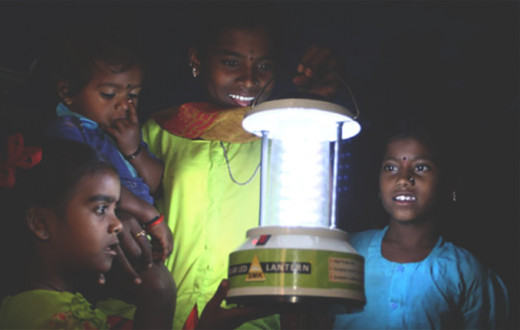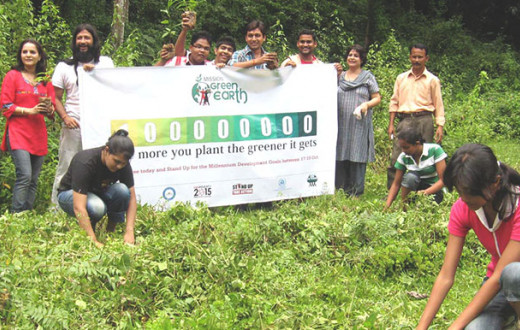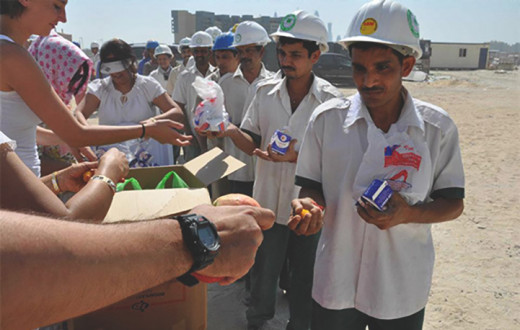Any country’s progress is directly connected with rural development. Lasting rural transformation can be achieved only with a holistic approach, one that considers and integrates all aspects including economic, social and environmental. For any change to be sustainable, it has to begin from within. In rural development programs run by The Art of Living, the emphasis is on empowering the local communities and making them the torch bearers of change. The ‘Youth Leadership Training Program’ (YLTP) gives youth the skills, motivation and abilities to initiate and lead service projects in their own villages and communities based on their needs. It is this combination of personal inner strength, as well as skills and leadership training that enables them on the journey of rural development.
Approach
The fulcrum of rural transformation of The Art of Living in India is the empowerment of the rural youth leader, called ‘Yuvacharya’. These are bright young men and women drawn from the same rural milieu and developed on multiple facets by the Youth Leadership Training Program (YLTP).
This gives them the skills, motivation, and abilities to initiate and lead service projects in their own villages and communities based on their needs. It is this combination of inner strength as well as skills and leadership training that enables them on the journey of rural development.
Yuvacharyas leverage The Art of Living model of development, called the 5H:
- Health – physical, mental, financial, and environmental
- Homes for the homeless
- Hygiene
- Human Values
- Harmony in Diversity
The 5H catalyzes social transformation and aims to eradicate poverty, misery, and disease and to ensure peace and harmony in rural and tribal areas worldwide.
Impact in India
70,000 villages
reached
227,895 India rural youth
Trained through YLTP
165,000 free stress-relief workshops
Conducted benefiting more than 5,688,000 people
90,200 hygiene camps
Conducted, benefiting 78,69,900 people
27,427 medical camps
benefiting 577,400 people
3,819 homes
built, impacting the socio-economic conditions of families
62,000 toilets
built, improving the health of local villagers
1,199 bore-wells
built, offering a regular supply of water
1000 bio-gas plants
built, offering alternate fuel solutions
55 model villages
Developed
65,000+ people
across 16,500 households benefit from solar light distribution
98 solar entrepreneurs
trained, providing clean energy to 4,000 rural families
Featured Rural Transformation Service Projects
360 million people in India i.e. roughly 40 percent of rural households do not have access to electricity. A majority of these people rely on kerosene and other fuels to meet their lighting needs, which is hazardous to both their health and to the environment. Every year 2.2 million litres of kerosene is burned for lighting, emitting approximately 5.5 million tonnes of carbon dioxide. Traditional fuel combustion, the primary source of indoor air pollution, causes between 300,000-400,000 deaths per year in India alone.
Initiated in 2012, The Art of Living’s vision to ‘Light a Million Homes’ is an on-going campaign inspiring individuals and corporate partners to work with us to bring clean and affordable lighting solutions to un-electrified homes and villages in India and in Nepal.
The Light a Home follows an integrated approach that combines multiple elements of rural transformation including building rural entrepreneurs. While there is still a journey to be completed, smiles are already lighting up thousands of faces as they begin to experience the benefits of this project.
Some highlights:
- Assam: India’s largest solar battery charging station launched to power 287 houses on a remote island in Dibrugarh, Assam in December 2016. With women heading the implementation, the portable solution has been installed on a sandy island.
- Arunachal Pradesh: 33 homes light up in the remote regions
- Jammu & Kashmir: Two schools fully electrified after the 2014 floods
- Tamil Nadu: A remote tribal settlement of Kodamban Kombai in the Nilgiri forest was electrified for the first time
- Karnataka: Three remote villages on the border of Karnataka and Goa got electricity for the first time in their history
- Maharashtra: Solar lamps provide portable electricity to nomadic laborers who are migrants and travel from place to place








